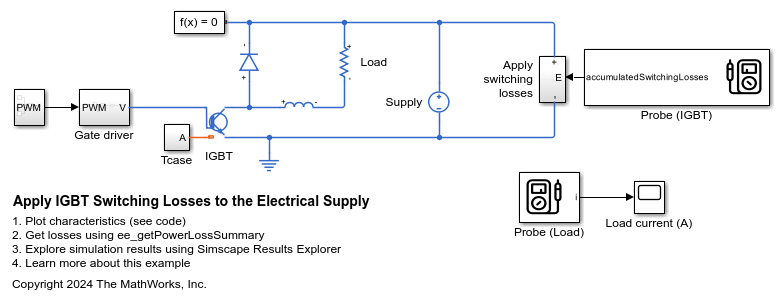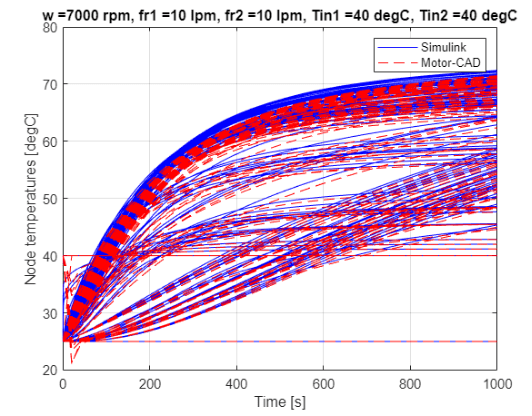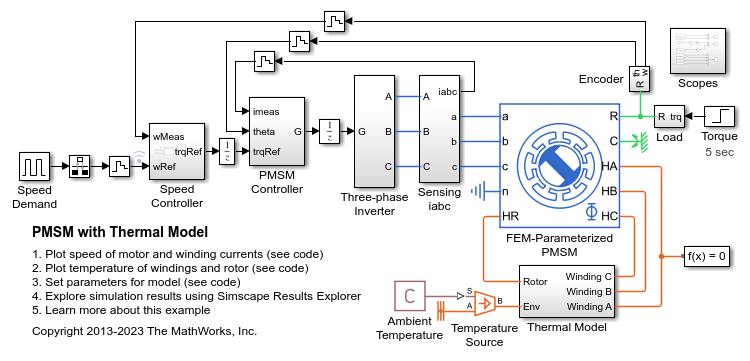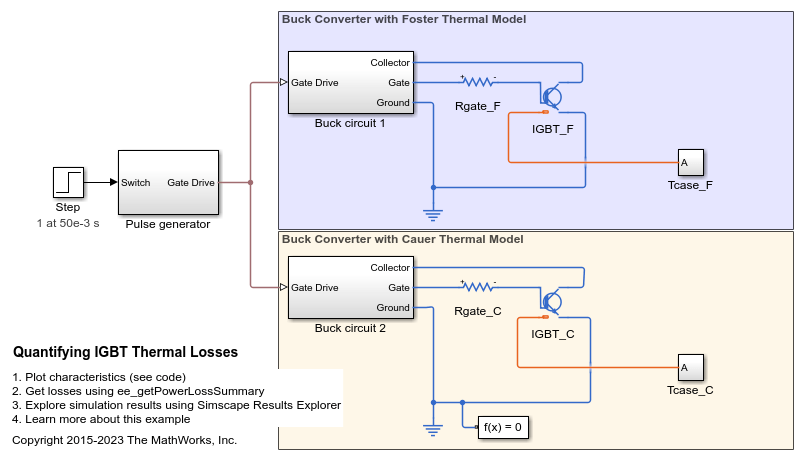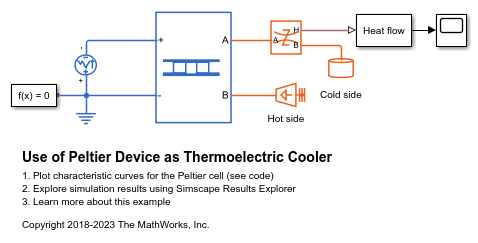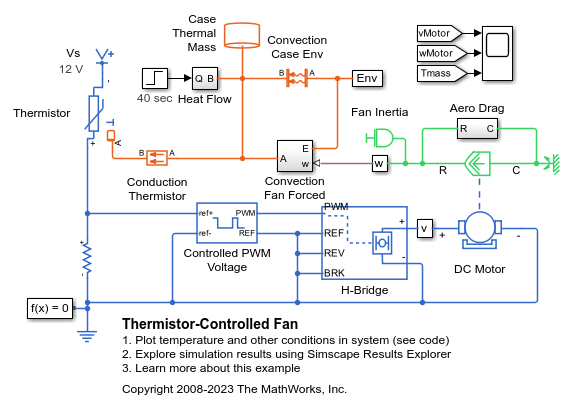热建模和管理
利用这些示例了解如何对热依赖关系和网络进行建模和管理。
精选示例
Apply IGBT Switching Losses to Electrical Supply
Draw semiconductor switching losses from the electrical supply. Simscape™ Electrical™ contains models of individual semiconductor switching devices, sometimes referred to as discretes. Discrete ideal switching device models, such as the IGBT (Ideal, Switching) library block, apply switching losses to the thermal port by stepping the junction temperature at switching events. However, these blocks do not draw an equivalent amount of energy from the power supply at a switching event. If your circuit has a half-bridge structure, you can draw equivalent energy from the supply using a Half-Bridge (Ideal, Switching) block instead of using discretes. This example shows how to draw equivalent energy from discretes using a Probe block.
- 自 R2025a 起
- 打开脚本
Import a Motor-CAD Thermal Model in Simulink and Simscape
Import an Ansys Motor-CAD motor model in Simulink®. This example also contains a previously generated Simulink reduced-order thermal model (SROTM) of an interior permanent magnet synchronous motor (IPMSM) with housing water jacket and self-ventilated cooling. You can download this model in MATLAB® or access it from MATLAB Central File Exchange and GitHub®.
- 自 R2023b 起
- 打开实时脚本
量化 IGBT 热损耗
此示例展示了如何基于绝缘栅双极晶体管 (IGBT) 中的开关和导通损耗生成温度曲线。此示例中包含两个降压转换器。其中一个转换器的 IGBT 连接到 Foster 热模型。另一个转换器的 IGBT 连接到 Cauer 热模型。热模型的参数经过调节,可以提供大致相同的结果。在 50 毫秒的仿真时间内,驱动频率从 40 kHz 变为 20 kHz,这增加了导通损耗并降低了开关损耗。损耗的变化导致 IGBT 温度发生相应变化。
Simple Induction Hob Simulation
Model a simple induction hob system using Simscape™ Electrical™ libraries. This model focuses on the electromagnetic effect of the winding coils and the eddy current effect in the cooking pot.
Use of Peltier Device as Thermoelectric Cooler
A Peltier device working in cooling mode with a hot side temperature of 50 degC. In cooling mode, the Coefficient of Performance (COP) of the Peltier cell is equal to the total heat transferred through the Thermoelectric cooler (TEC) divided by the electric input power, COP = Qc/Pin.
Thermistor-Controlled Fan
How fundamental thermal, mechanical and electrical components can be used to model a thermistor-controlled fan. The heat-generating device starts producing 2 watts at time zero, and then at 40 seconds this increases to 20 watts. The thermistor therefore heats up, and its resistance decreases thereby increasing the voltage across the PWM reference pins. This increases the PWM frequency which in turn increases average motor current, and the fan speeds up. The additional fan speed increases the convective cooling of the device, moderating the temperature increase of the device.
Optimize Liquid Cooling System of Inverter
Analyze the performance of a liquid cooling system for a three-phase inverter. To find the steady-state temperatures and losses, you first run detailed and reduced order models (ROM). Then you compute the optimal size of the heatsink that maximizes the inverter efficiency and minimizes the lifetime cost.
MATLAB Command
You clicked a link that corresponds to this MATLAB command:
Run the command by entering it in the MATLAB Command Window. Web browsers do not support MATLAB commands.
选择网站
选择网站以获取翻译的可用内容,以及查看当地活动和优惠。根据您的位置,我们建议您选择:。
您也可以从以下列表中选择网站:
如何获得最佳网站性能
选择中国网站(中文或英文)以获得最佳网站性能。其他 MathWorks 国家/地区网站并未针对您所在位置的访问进行优化。
美洲
- América Latina (Español)
- Canada (English)
- United States (English)
欧洲
- Belgium (English)
- Denmark (English)
- Deutschland (Deutsch)
- España (Español)
- Finland (English)
- France (Français)
- Ireland (English)
- Italia (Italiano)
- Luxembourg (English)
- Netherlands (English)
- Norway (English)
- Österreich (Deutsch)
- Portugal (English)
- Sweden (English)
- Switzerland
- United Kingdom (English)
